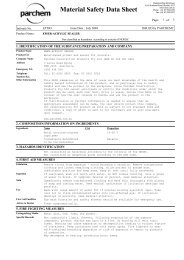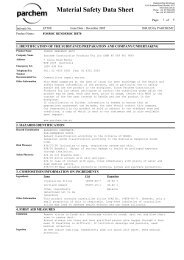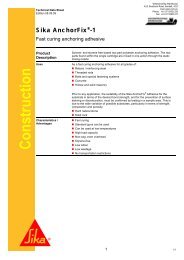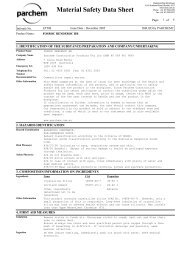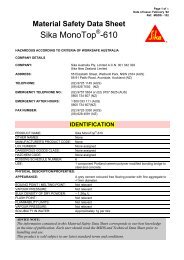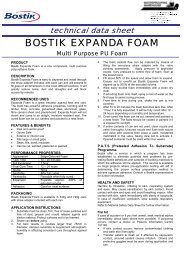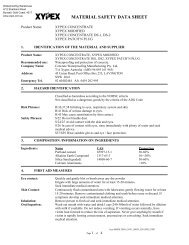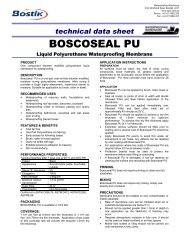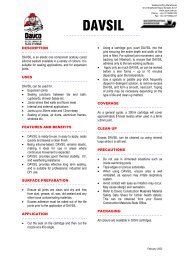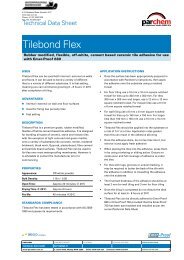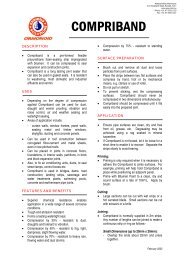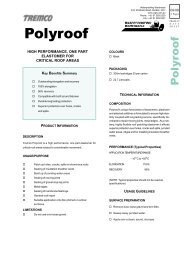Safety Data Sheet - Waterproofing Warehouse
Safety Data Sheet - Waterproofing Warehouse
Safety Data Sheet - Waterproofing Warehouse
You also want an ePaper? Increase the reach of your titles
YUMPU automatically turns print PDFs into web optimized ePapers that Google loves.
<strong>Safety</strong> <strong>Data</strong> <strong>Sheet</strong>According to NOHSC:2011(2003)Version: 1.0 Page: 1 of 5Revised: 15 May 2006 MSDS No: 287NOT CLASSIFIED AS HAZARDOUS ACCORDING TO NOHSC CRITERIA1. Identification of the substance/preparation and companyProduct:Sikaflex PROReommended use:SealantManufacturer/supplier information:Manufacturer/supplier:Sika Australia Pty LtdStreet/postbox:55 Elizabeth StreetTown/city and Post Code: WETHERILL PARK NSW 2164Country:AUSTRALIAPhone: (02) 9725 1145Fax: (02) 9725 3330General informationOperations ManagerEmergency information phone: 1800 033 1112. Composition/information on ingredientsChemical characterization:Filled reactive PUR-polymersHazardous ingredients:Ingredient CAS No ConcentrationXylene 1330-20-7 3.7%3. Hazard identificationHazard Category:None allocated.4. First-aid measuresInhalation:Ensure supply of fresh air.In the event of symptoms take medical treatment.Skin contact:If skin or hair contact occurs, remove contaminated clothing and flush skin and hair with running water.Consult a doctor if irritation persists.Eye contact:If in eyes, hold eyelids apart and flush the eyes continuously with running water. Continue flushinguntil advised to stop by the Poisons Information Centre or a Doctor; or for at least 15 minutes and seekmedical attention immidietly.4. First-aid measures continuedIngestion:If poisoning occurs, contact a doctor or Poisons Information Centre (Phone Australia 131 126, NewZealand 0800 764 766). Rinse mouth with water. If swallowed, do NOT induce vomiting. Give a glassof water to drink. Never give anything by the mouth to an unconscious patient. If vomiting occurs givefurther water. Seek medical advice.Notes to physician:
<strong>Safety</strong> <strong>Data</strong> <strong>Sheet</strong>According to NOHSC:2011(2003)Version: 1.0 Page: 2 of 5Revised: 15 May 2006 MSDS No: 287Treat symptomatically. Effects may be delayed.5. Fire-fighting measuresSpecific hazards:In the event of fire oxides of carbon and nitrogen can be released.Special protective precautions and equipment:On burning may emit toxic fumes. Fire fighters to wear self-contained breathing apparatus and suitableprotective clothing if risk of exposure to vapour or products of combustion.Suitable extinguishing media:If material is involved in a fire use water fog (or if unavailable fine water spray), foam, dry agent (carbondioxide, dry chemical powder).6. Accidental release measuresSmall Spills:Ensure adequate ventilation. Wear protective equipment to prevent skin and eye contamination.Wipe up with absorbent (clean rag or paper towels). Collect and seal in properly labelled containers ordrums for disposal.Do not allow to enter drains or waterways.In case of entry into waterways, soil or drains, inform responsible authorities.7. Handling and storageHandling:See chapter 8 personal protective equipment.Provide good ventilation in working area.Keep away from sources of ignition.Storage:Store in a cool, dry, well-ventilated place and out of direct sunlight , frost atmospheric moisture andwater. Store away from food, beverages and animal feedstock. Keep containers closed when not inuse - check regularly for leaks.8. Exposure controls/personal protectionNational occupational exposure limits:No value assigned for this specific material by the NOHSC Australia.However for:TWA STEL CARCINOGEN NOTICESppm mg/m3 ppm mg/m3 CATEGORYXylene 80 350 150- 655As published by the NOHSC Australia.Biological Limit Values:As per the “National Model Regulations for the Control of Workplace Hazardous Substances [NOHSC:1005 (1994)]” the ingredients in this material do not have a Biological Limit Allocated.Engineering measures:Ensure ventilation is adequate to maintain air concentrations below Exposure Standards. Naturalventilation should be adequate under normal use conditions.
<strong>Safety</strong> <strong>Data</strong> <strong>Sheet</strong>According to NOHSC:2011(2003)Version: 1.0 Page: 3 of 5Revised: 15 May 2006 MSDS No: 287Personal protection equipment:OVERALLS, SAFETY SHOES, CHEMICAL GOGGLES, GLOVES.Wear overalls, chemical goggles and impervious gloves. Due to variations in glove construction andlocal conditions, the user should make an assessment of the appropriate gloves to use. Wash handsbefore smoking, eating, drinking or using the toilet. Wash contaminated clothing and other protectiveequipment before storing or re-using. If risk of inhalation of exists, wear organic vapour/particulaterespirator meeting the requirements of AS/NZS 1715 and AS/NZS 1716.9. Physical and chemical propertiesAppearance:Physical state: PasteColour:White, Grey, Black and other coloursOdour:Characteristic<strong>Data</strong> relevant to safety:Solubility:Insoluble (reacts with water).Specific Gravity (20 °C): 1.27Vapour Pressure (20 °C):N AvFlash Point (°C): 56Flammability Limits (%):N Av(Typical values only - consult specification sheet)N Av = Not available10. Stability and reactivityChemical stability:This material is thermally stable when stored and used as directed.Conditions to avoid:Elevated temperatures and sources of ignition.If product reacts with water within the sealed container it forms carbon dioxide and pressure may rise.Reactions possible with amines, alcohol and water.Hazardous decomposition products:Oxides of carbon and nitrogen, smoke and other toxic fumes.Hazardous reactions:No information available.11. Toxicological informationNo adverse health effects expected if the product is handled in accordance with this <strong>Safety</strong> <strong>Data</strong> <strong>Sheet</strong> andthe product label. Symptoms or effects that may arise if the product is mishandled and overexposure occursare:Acute Effects:
<strong>Safety</strong> <strong>Data</strong> <strong>Sheet</strong>According to NOHSC:2011(2003)Version: 1.0 Page: 4 of 5Revised: 15 May 2006 MSDS No: 287SensitisationAllergic reaction can occur with sensitive persons.Inhalation: Material may cause irritation. Vapours have a narcotic effect.Skin contact: May cause irritation.Eye contact: May cause irritation.Ingestion:No information available.Long Term Effects:No information available for product.Acute toxicity / Chronic toxicity:Xylene : Oral LD50 (rat) 4,300mg/kg.12. Ecological informationAvoid contaminating waterways.Ecotoxicity:No information available.Persistence and degradability:No information available.Mobility:No information available.13. Disposal considerationsRefer to State/Territory Land Waste Management Authority.14. Transport informationADG/ADR/RIDNot classified as Dangerous Goods by the criteria of the ADG Code.IMDGNot classified as Dangerous Goods by the criteria of the IMDG Code for transport by sea.IATANot classified as Dangerous Goods by the criteria of the IATA Dangerous Goods Regulations fortransport by air.15. Regulatory informationPoisons Schedule (Aust):Not sceduled.All the constituents of this material are listed on the Australian Inventory of Chemical Substances (AICS).
<strong>Safety</strong> <strong>Data</strong> <strong>Sheet</strong>According to NOHSC:2011(2003)Version: 1.0 Page: 5 of 5Revised: 15 May 2006 MSDS No: 28716. Other informationReason(s) For Issue: RevisedMaterial <strong>Safety</strong> <strong>Data</strong> <strong>Sheet</strong>s are updated frequently. Please ensure that you have a current copy. MSDSmay be obtained from the following website: www.sika.com.auThe information contained in this <strong>Safety</strong> Date <strong>Sheet</strong> corresponds to our level of knowledge at the time ofpublication. All warranties are excluded. Our most current General Sales Conditions shall apply. Pleaseconsult the Technical <strong>Data</strong> <strong>Sheet</strong> prior to any use and processing.



